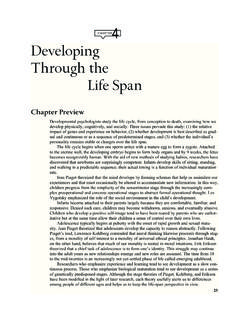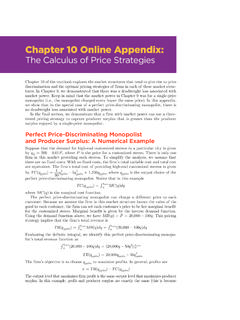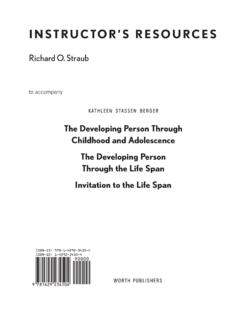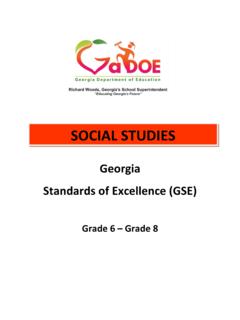Transcription of Word Searches - Macmillan Learning
1 A P P E N D I X :D. Word Searches *Answers follow starting on page D-40. D-1. D-2 APPENDIX D. CHAPTER 1 WORD SEARCH. Appendix D D-3. Chapter 1 CLUES 12. _____ A person who devi- ates from common behavior patterns or displays 1. _____ A procedure de- odd or whimsical behvior. signed to help change abnormal behavior into more normal behavior. Also called therapy. 13. _____ The view that the chief causes of abnormal functioning are psy- 2. _____ A society's stated chological. and unstated rules for proper conduct. 14. _____ Interventions 3. _____ Classification of aimed at deterring mental disorders before they drugs that mainly affect the brain and reduce can develop. many symptoms of mental dysfunctioning. 15. _____ An ancient opera- 4. _____ The practice, begun tion in which a stone instrument was used to in the 1960s, of releasing hundreds of thousands cut away a circular section of the skull, perhaps of patients from public mental hospitals. to treat abnormal behavior.
2 5. _____ An arrangement in 16. _____ Either the theory or which a person directly pays a therapist or the treatment of abnormal mental functioning counseling services _____ psychotherapy. that emphasizes unconscious psychological 6. _____ The study and en- forces as the cause of psychopathology. hancement of positive feelings, traits, and abili- 17. _____ The practice in ties _____ psychology. early societies of treating abnormality by coax- 7. _____ The view that ab- ing evil spirits to leave the person's body. normal psychological functioning has physical 18. _____ The field of psy- causes. chology that examines the impact of culture, 8. _____ According to Greek race, ethnicity, gender, and similar factors on and Roman physicians, bodily chemicals that in- our behaviors and thoughts, and also focuses on fluence mental and physical functioning. how such factors may influence the origin, na- 9. _____ A nineteenth-cen- ture, and treatment of abnormal behavior.
3 Tury approach to treating people with mental 19. _____ State-run public dysfunction that emphasized moral guidance mental institutions in the United States. [two and humane and respectful treatment. [two words ]. words ]. 20. _____ A people's common 10. _____ The scientific study history, values, institutions, habits, skills, tech- of abnormal behavior in an effort to describe, nology, and arts. predict, explain, and change abnormal patterns of functioning. [two words ]. 11. _____ A type of institu- tion that first became popular in the sixteenth century to provide care for persons with mental disorders. Most became virtual prisons. D-4 APPENDIX D. CHAPTER 2 WORD SEARCH. Appendix D D-5. Chapter 2 CLUES 11. _____ A type of study that measures the incidence and prevalence of a 1. _____ A research proce- disorder in a given population. dure in which a variable is manipulated and the effect of the manipulation is observed. 12. _____ An experimental design in which subjects do not know whether 2.
4 _____ A type of study they are in the experimental or the control con- that observes the same subjects on many occa- dition. [two words ]. sions over a long period of time. 13. _____ The process of sys- 3. _____ The variable in an tematically gathering and evaluating informa- experiment that is expected to change as the in- tion through careful observations to gain an un- dependent variable is manipulated. derstanding of a phenomenon. [two words ]. 4. _____ The accuracy with 14. _____ The degree to which a study can pinpoint one of various pos- which events or characteristics vary along with sible factors as the cause of a phenomenon. [two each other. words ]. 15. _____ A sham treatment 5. _____ In an experiment, a that the subject in an experiment believes to be group of subjects who are not exposed to the in- genuine. [two words ]. dependent variable. [two words ]. 16. _____ The variable in an 6. _____ A detailed account experiment that is manipulated to determine of a person's life and psychological problems.
5 Whether it has an effect on another variable. [two words ]. 17. _____ The degree to 7. _____ The number of new which the results of a study may be generalized cases of a disorder occurring in a population beyond that study. [two words ]. over a specific period of time. 18. _____ A selection proce- 8. _____ An experiment in dure that ensures that subjects are randomly which investigators make use of control and ex- placed either in the control group or in the ex- perimental groups that already exist in the perimental group. [two words ]. world at large. Also called a mixed design. [two words , hyphenated] 19. _____ In an experiment, a variable other than the independent variable 9. _____ A research method that is also acting on the dependent variable. in which the experimenter produces abnormal- like behavior in laboratory subjects and then 20. _____ The total number conducts experiments on the subjects. [two of cases of a disorder occurring in a population words ] over a specific period of time.
6 10. _____ A general under- standing of the nature, causes, and treatments of abnormal psychological functioning in the form of laws or principles. D-6 APPENDIX D. CHAPTER 3 WORD SEARCH. Appendix D D-7. Chapter 3 CLUES 11. _____ A form of biologi- cal treatment, used primarily on depressed pa- 1. _____ Psychotropic drug tients, in which a brain seizure is triggered as an type that improves the moods of people with electric current passes through electrodes at- depression. tached to the patient's forehead. 2. _____ A set of assump- 12. _____ The tiny space be- tions and concepts that help scientists explain tween the nerve ending of one neuron and the and interpret observations. Also called a para- dendrite of another. digm. 13. _____ A therapy format in 3. _____ According to which a group of people with similar problems Freud, the psychological force that employs rea- meet together with a therapist to work on those son and operates in accordance with the reality problems.
7 Principle. 14. _____ A behavioral treat- 4. _____ A nerve cell. ment in which clients with phobias learn to 5. _____ A chemical that, re- react calmly instead of with intense fear to the leased by one neuron, crosses the synaptic space objects or situations they dread systematic to be received at receptors on the dendrites of _____. neighboring neurons. 15. _____ A site on a neuron 6. _____ A type of therapy that receives a neurotransmitter. developed by Aaron Beck that helps people rec- 16. _____ Brain surgery for ognize and change their faulty thinking mental disorders. processes. 17. _____ A process of learn- 7. _____ According to ing in which an individual acquires responses Freud, a condition in which the id, ego, and by observing and imitating others. superego do not mature properly and are frozen at an early stage of development. 18. _____ According to Freud, the psychological force that produces in- 8. _____ A process of learn- stinctual needs, drives, and impulses.
8 Ing in which behavior that leads to satisfying consequences is likely to be repeated. [two 19. _____ Explanation that at- words ] tributes the cause of abnormality to an interac- tion of genetic, biological, developmental, emo- 9. _____ Drug classification tional, behavioral, cognitive, social, and societal that primarily affect the brain and reduce many influences. symptoms of mental dysfunction. 20. _____ The psychody- 10. _____ The humanistic namic theory that views the desire for relation- therapy developed by Carl Rogers in which cli- ships as the key motivating force in human be- nicians try to help clients by conveying accept- havior. [three words ]. ance, accurate empathy, and genuineness. [three words ; hyphenated]. D-8 APPENDIX D. CHAPTER 4 WORD SEARCH. Appendix D D-9. Chapter 4 CLUES 11. _____ A type of test that measures physical responses (such as heart rate 1. _____ A technique for ob- and muscle tension) as possible indicators of serving behavior in which clients observe them- psychological problems.
9 Selves. [two words ; hyphenated]. 12. _____ The accuracy of a 2. _____ The process of col- test's or study's results; that is, the extent to lecting and interpreting relevant information which the test or study actually measures or about a client or subject. shows what it claims. 3. _____ A cluster of symp- 13. _____ A series of tests, toms that usually occur together. each of which produces a different kind of data. 4. _____ A set of interview 14. _____ An understanding questions and observations designed to reveal of the behavior of a particular individual. the degree and nature of a client's abnormal functioning. [three words ] 15. _____ A general score de- rived from intelligence tests that is considered 5. _____ A type of test con- to represent a person's overall level of intelli- sisting of ambiguous material that people inter- gence. [two words ]. pret or respond to. 16. _____ A list of disorders, 6. _____ The process in along with descriptions of symptoms and which a test is administered to a large group of guidelines for making appropriate diagnoses.
10 Persons whose performance then serves as a [two words ]. common standard or norm against which any individual's score can be measured. 17. _____ An effort to iden- tify a set of common strategies that run through 7. _____ A method for ob- the work of all effective therapists;. serving behavior in which people are observed _____ movement in artificial settings such as clinicians' offices or laboratories. 18. _____ A type of test that directly measures brain structure or activity. 8. _____ A measure of the consistency of test or research results. 19. _____ A face-to-face en- counter in which clinicians ask questions of 9. _____ A determination clients, weigh their responses and reactions, and that a person's problems reflect a particular dis- learn about them and their psychological prob- order. lems. [two words ]. 10. _____ A device for gather- 20. _____ A method for ob- ing information about a few aspects of a per- serving behavior in which clinicians or re- son's psychological functioning from which searchers observe people in their everyday envi- broader information about the person can be in- ronments.














